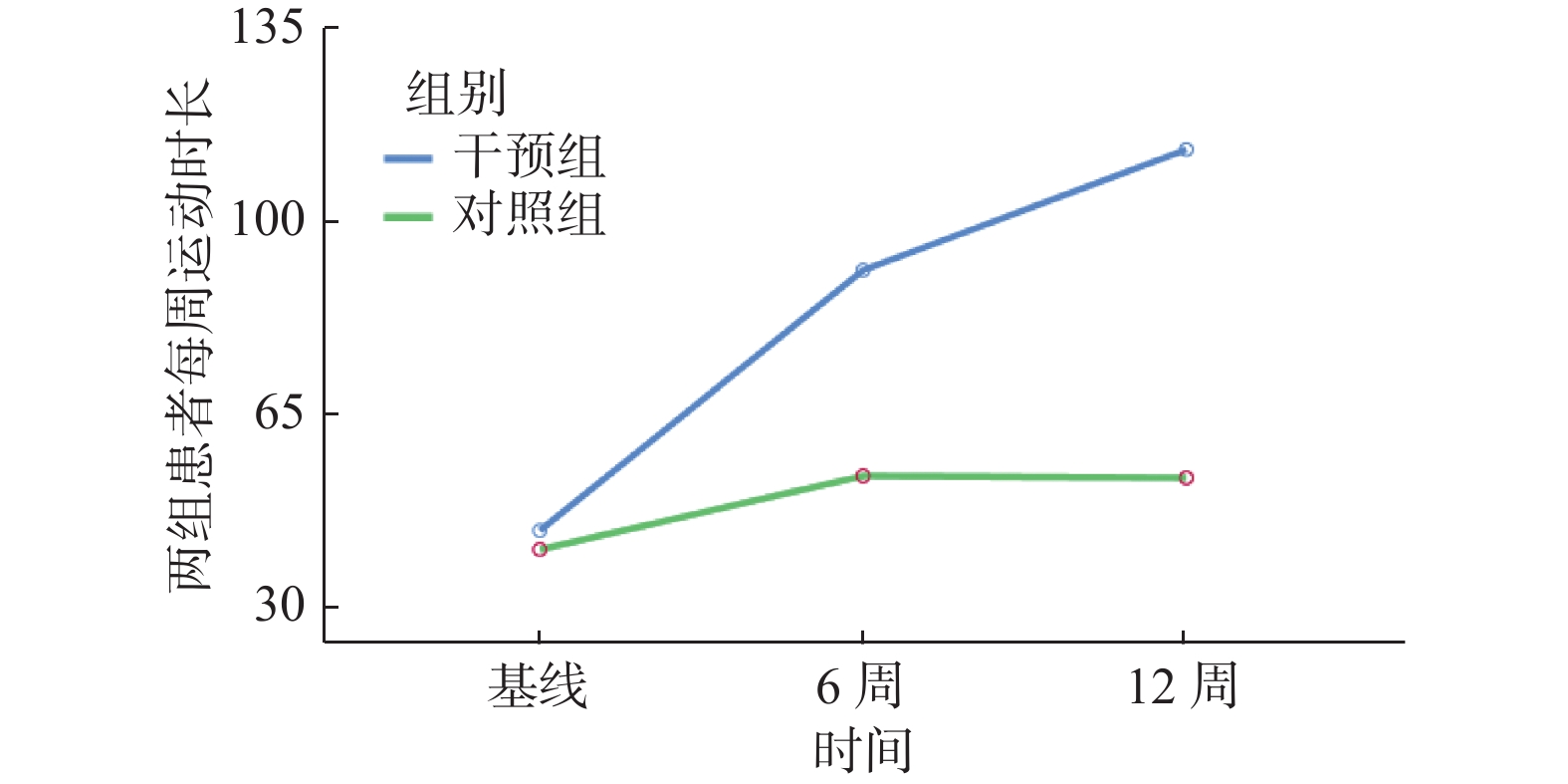Effect of HAPA Qualitiative Exercise Management on Exercise Compliance of Patients with Coronary Heart Disease Based on Excellent Care Platform
-
摘要:
目的 帮助稳定性冠心病患者出院后,有效提高运动依从性,真正实现冠心病患者院外的自我健康管理。 方法 随机数字表法将昆明医科大学附属延安医院全科医学科心血管病区稳定性冠心病患者70例,分为对照组35例、干预组35例。对照组实施心脏康复护理,干预组在心脏康复护理中构建“基于优护 + 平台的HAPA量化运动管理模式”。对比分析“基于优护 + 平台的HAPA量化运动管理模式”对2组患者运动依从性的影响。 结果 干预12周后,干预组运动频率多于对照组,差异有统计学意义(P < 0.05);干预12周后,干预组运动时间多于对照组,差异有统计学意义(P < 0.05); 2组每周运动时间情况进行重复测量方差分析,时间效应、组间效应、交互效应均有统计学意义(P < 0.01)。干预后6周和12周,对比每周运动时长,干预组均优于对照组,差异均有统计学意义(P < 0.05)。且干预组每周运动时长,随着时间进展,增加幅度和速度优于对照组。 结论 “基于优护 + 平台的HAPA量化运动管理”可有效提高稳定性冠心病患者的运动依从性。量化版FITT运动管理方案既符合患者运动喜好,又促进安全、规律运动。HAPA针对患者不同行为阶段,实施对应的量化运动管理措施,促进患者的运动行为意向转化为外在行为。运用优护 + 平台对HAPA量化运动管理实施监督与指导,有效保障冠心病患者运动行为的产生与维持。 Abstract:Objective Help stable patients with coronary heart disease effectively improve exercise compliance after discharge, and achieve self-health management for patients with coronary heart disease. Methods 70 patients with stable coronary heart disease were divided into control group (35 cases) and intervention group (35 cases) by random number table method. The control group received cardiac rehabilitation nursing, while the intervention group received a “HAPA quantitative exercise management model based on excellent care platform” in cardiac rehabilitation nursing care. The effect of "HAPA quantified exercise management mode based on excellent care platform on exercise compliance of patients in 2 groups was compared and analyzed. Results After 12 weeks of intervention, the exercise frequency in the intervention group was significantly higher than that in the control group (P < 0.05). After 12 weeks of intervention, the exercise time in the intervention group was longer than that in the control group, with a statistically significant difference (P < 0.05). Repeated measurement ANOVA was performed on the weekly exercise time of the two groups, and the time effect, inter-group effect and interaction effect were statistically significant (P < 0.01). At 6 weeks and 12 weeks after intervention, the weekly exercise duration in the intervention group was better than that in the control group, with statistical significance (P < 0.05). The duration of exercise per week in the intervention group was better than that in the control group as time progressed. Conclusion HAPA quantitative exercise management based on the excellence care platform" can effectively improve the exercise compliance of patients with stable coronary heart disease. The quantified FITT exercise management solution fits patients’ exercise preferences while promoting safe, regular exercise. According to different behavioral stages of patients, HAPA implements corresponding quantitative exercise management measures to promote the transformation of patients’ motor behavior intentions into external behaviors. The use the excellent care platform to supervise and guide the quantitative exercise management of HAPA effectively guarantees the generation and maintenance of exercise behavior in patients with coronary heart disease. -
表 1 2组基础资料的比较 [n(%)]
Table 1. Comparison of basic data between two groups [n(%)]
一般资料 类别 干预组(n = 32) 对照组(n = 30) x2/t P 年龄[岁,($\bar x \pm s $)] 64.16 ± 4.50 62.88 ± 4.12 0.016 0.987 性别 男 18(56.2) 18(60.0) 0.243 0.799 女 14(43.8) 12(40.0) 文化程度 小学及以下 3(9.4) 6(20.0) 2.491 0.477 初中 9(28.1) 10(33.3) 高中 15(46.9) 9(30.0) 专科及以上 5(15.6) 5(16.7) 工作状况 无工作 4(12.5) 6(20.0) 1.618 0.445 退休/病休 20(62.5) 14(46.7) 在职 8(25.0) 10(33.3) 医保类型 全部报销 4(12.5) 6(20.0) 0.927 0.629 部份报销 23(71.9) 21(70.0) 自费 5(15.6) 3(10.0) 既往史 无 7(21.9) 10(33.3) 1.199 0.549 1种 16(50.0) 14(46.7) 2种/2种以上 9(28.1) 6(20.0) 冠脉血管病变数 单支血管病变 19(59.4) 17(56.7) 0.295 0.863 双支血管病变 11(34.4) 10(33.3) 3支/3支以上 2(6.2) 3(10.0) 支架数目 0个 21(65.6) 14(46.7) 2.265 0.322 1个 9(28.1) 13(43.3) 2个/2个以上 2(6.3) 3(10.0) 运动习惯 经常(≥3次/周) 2(6.2) 3(10.0) 0.581 0.748 偶尔(1~2次/周) 4(12.5) 5(16.7) 几乎不锻炼(<2次/月) 26(81.3) 22(73.3) 表 2 稳定性冠心病患者的心脏康复常规护理措施
Table 2. Routine Nursing Measures for Cardiac Rehabilitation of Patients with Stable Coronary Heart Disease
项目 稳定性冠心病患者的心脏康复常规护理措施 五大处方 心脏康复常规护理措施 药物处方 根据医嘱按时服药,出院后不可随意停药; 运动处方 根据康复师指导进行运动,鼓励出院后坚持规律运动; 营养处方 根据营养师要求控制饮食,低糖、低脂、适量蛋白质、足量维生素; 戒烟处方 明确吸烟危害,出院后做到不复吸; 心理处方 规律生活,充足睡眠,避免过劳,稳定情绪; 表 3 基于BMI值的个体化运动方式(kg/m2)
Table 3. Individualized exercise mode According to the patient’s BMI value (kg/m2)
项目 根据患者BMI值,制定个体化运动方式 体重 BMI 运动方式 轻体重 BMI≤18.4 常规有氧运动 健康体重 18.5≤BMI<23.9 常规有氧运动 超重 24≤BMI<27.9 有氧运动时避免跑跳等对膝盖损伤的运动方式 肥胖 28≤BMI 有氧运动时避免跑跳等对膝盖损伤的运动方式 表 4 量化版FITT运动处方
Table 4. Quantitative FITT exercise prescription
项目 稳定性冠心病患者的量化版FITT运动处方 FITT原则 具体内容 运动频率 frequency (1)根据患者每小时消耗的热量计算出该运动方式每周需完成的总时长(参考推荐[14]每周总时间至少150 min);
(2)1周内可安排3~5 d完成;
(3)1d运动时间可碎片化分次完成(每次最少10 min[15]);
(4)每日运动时间累积不低于30 min;
(5)运动间歇不超过3 d;运动强度 intensity (1)每周能量消耗目标1 000 kcal;
(2)运动强度需适量,以患者稍出汗、呼吸轻微加快、无胸闷气促为宜;
(3)患者可利用BORG疲劳自评量表自行测量运动强度(运动强度在12-14级,
即自我感觉“有点吃力”即可);运动形式 type 有氧运动为主:步行、慢跑、太极拳、八段锦、骑车、广场舞、游泳、上举哑铃等; 运动时间 time 热身5~10 min,正式运动30 min,拉伸放松10 min; 安全管理 (1)初次运动可从30 min开始,采用间歇式运动法(间隔休息1~5 min),逐渐延长锻炼时间;
(2)运动过程中出现气急、头晕、乏力等应停止运动;
(3)运动应循序渐进;
(4)不宜空腹或饱餐时运动;
(5)运动服装舒适透气;表 5 构建HAPA模式的运动管理方案
Table 5. Construction of HAPA mode exercise management scheme
构建HAPA模式的运动管理方案 行为阶段 干预内容 前意向阶段 入院 1~3 d 阶段特点 患者未形成运动行为意愿; 干预重点 感知运动风险、预期运动结果; 干预目的 通过建立风险意识和积极预期结果,激发内在运动动机,
通过自我行动效能,形成运动行为意愿;干预措施 (1)健康教育运动锻炼对疾病的长期获益性;
(2)通过住院期间的“同伴教育”,激发患者内在运动动机;
(3)要求患者关注优护+平台,推送冠心病运动科普内容,
进行警示教育,为后续工作奠定基础;意向阶段 入院 3~5 d 阶段特点 患者有运动行为意愿,但无明确计划、未行动; 干预重点 根据患者BMI值,量化运动管理方案; 干预目的 了解患者需求、打破阻碍因素,促进意向转化为行动,提高运动行为积极性; 干预措施 (1)运动健康教育:FITT原则、长期获益性、相关运动指导和注意事项;
(2)根据患者个人喜好及生活习惯,量化制定个体化运动方案;
(3)要求患者学习记录运动日志,监督每日打卡优护+平台;行动阶段 入院 5~7 d至出院前 阶段特点 患者已经产生运动行为; 干预重点 出院后维持规律运动的健康行为; 干预目的 强化自我效能,维持规律运动行为的不中断; 干预措施 (1)通过优护+平台提醒服务,有效督促患者每日运动打卡;
(2)通过优护+平台,实现动态评估、时时调整运动方案;
(3)通过优护+平台在线交流,实现患者同伴之间的相互督促和激励;
(4)通过优护+平台在线交流,实现患者家属共同参与运动,
有效阻断患者的消极情绪;
(5)通过优护+平台,推送冠心病科普内容,延续健康教育;表 6 干预前后2组运动依从性比较 [n(%)]
Table 6. Comparison of exercise compliance between the two groups before and after intervention [n(%)]
项目 干预前 干预后 对照组(n = 30) 干预组(n = 32) 对照组(n = 30) 干预组(n = 32) 运动频率 经常(≥3次/周) 3 (10) 2(6.2) 6(20) 24(75) 偶尔(1~2次/周) 5 (16.7) 4(12.5) 7(23.3) 6(18.75) 几乎不锻炼(<2次/月) 22 (73.3) 26 (81.3) 17(56.7) 2(6.25) χ2 0.688 22.678 P 0.737 < 0.001* 运动时间 < 60 min/周 21(70.0) 19(59.4) 9(30.0) 1(3.1) 60~120 min/周 9(30.0) 12(37.5) 20(66.7) 15(46.9) 120~150 min/周 0 1(3.1) 1(3.3) 16(50.0) χ2 1.409 20.306 P 0.508 < 0.001* *P < 0.05。 表 7 干预前后2组每周运动时间情况比较 [(
$\bar x \pm s $ ),min]Table 7. Comparison of weekly exercise time between the two groups before and after intervention [(
$\bar x \pm s $ ),min]项目 时间 干预组 对照组 t P 运动时间(min/周) T0 43.4 ± 21.2 40.0 ± 17.2 0.698 0.488 T1 90.6 ± 23.5 53.3 ± 16.9 7.124 < 0.001* T2 112.5 ± 23.0 53.0 ± 14.9 12 < 0.001* t 0.735 6.582 P < 0.001* 0.502 T0表示基线;T1表示干预后6周;T2表示干预后12周;*P < 0.05。 表 8 干预前后2组自我效能得分比较 [(
$\bar x \pm s $ ),分]Table 8. Comparison of self-efficacy scores between the two groups before and after intervention [(
$\bar x \pm s $ ),score]项目 时间 干预组 对照组 t P 自我效能得分 干预前 22.66 ± 1.09 22.55 ± 1.18 0.357 0.722 干预12周后 34.51 ± 1.51 26.71 ± 1.25 22.08 < 0.001* *P < 0.001。 -
[1] Corra U,Piepoli M F,Carre F,et al. Secondary prevention through cardiac rehabilitation: physical activity counselling and exercise training: key components of the position paper from the Cardiac Rehabilitation Section of the European Association of Cardiovascular Prevention and Rehabilitation[J]. Eur Heart J,2010,31(16):1967-1974. doi: 10.1093/eurheartj/ehq236 [2] Carl,J,Lavie. Exercise and the cardiovascular system: clinical science and cardiovascular outcomes[J]. Circulation Research,2015,117(2):207-219. [3] 丁荣晶,胡大一,马依彤,等. 冠心病患者运动治疗中国专家共识[J]. 中华心血管病杂志,2015,43(07):575-588. [4] Eijsvogels T,Maessen M. Exercise for coronary heart disease patients: Little is good,more is better,vigorous is best.[J]. Journal of the American College of Cardiology,2017,70(14):1701-1703. doi: 10.1016/j.jacc.2017.08.016 [5] Torri A,PanzArino C,Scaglione A,et al. Promotion of home-based exercise training as secondary prevention of coronary heart disease: A PILOT WEB-BASED INTERVENTION[J]. Journal of cardiopulmonary rehabilitation and prevention,2018,38(4):1. doi: 10.1097/HCR.0000000000000300 [6] SmithP J,Sherwood A,Blumenthal J A. Effects of aerobic exercise on white matter hyperintensities: An exploratory analysis[J]. General Hospital Psychiatry,2018,53:84-85. [7] Powell R,McGregor G,Ennis S,et al. Is exercise-based cardiac rehabilitation effective? A systematic review and meta-analysis to re-examine the evidence[J]. BMJ Open,2018,8(3):e019656. doi: 10.1136/bmjopen-2017-019656 [8] 安俊清. 有氧运动对高龄冠心病患者经皮冠状动脉介入术后心肺功能及生存质量的影响[J]. 中国老年学杂志,2020,40(5):1010-1013. [9] 苏金虎,齐晓晖. 老年冠心病运动治疗的研究进展[J]. 医学综述,2020,26(22):4462-4466. doi: 10.3969/j.issn.1006-2084.2020.22.018 [10] 董娅珏,杨正义,方雪梅,等. 综合心脏康复对冠心病PCI术后患者运动耐力及生活质量的影响[J]. 当代护士(专科版),2019,26(11):1-3. [11] 中华医学会心血管病学分会介入心脏病学组,中华医学会心血管病学分会动脉粥样硬化与冠心病学组,中国医师协会心血管内科医师分会血栓防治专业委员会,等. 稳定性冠心病诊断与治疗指南[J]. 中华心血管病志,2018,46(9):680-694. [12] 赵桂蓉,任建辉,刘敏. 冠心病患者对运动康复训练的认知与态度分析[J]. 预防医学情报杂志,2019,35(9):991-994+1000. [13] 昝文明,严鹏仲,李永良,等. PCI治疗冠心病慢性心力衰竭对NYHA心功能分级的影响[J]. 贵州医药,2018,42(7):806-807. doi: 10.3969/j.issn.1000-744X.2018.07.013 [14] PellIccia A,Shar S,Gati S,et al. 2020 ESC Guidelines on sports cardiology and exercise in patients with cardiovascular disease[J]. Eur Heart J,2021,42(1):17-96. doi: 10.1093/eurheartj/ehaa605 [15] Steve B, AndreaL D, BessH M, et al. Active living every day(2nd edition)[M]. Illinois Human Kinetics, 2020: 208. [16] Schwarzer R,Born A. Optimistic self-beliefs: Assessment of general perceived self-efficacy in thirteen cultures[J]. World Psychology,1997,3(1):177-190. [17] 王才康,胡中锋,刘勇. 一般自我效能感量表的信度和效度研究[J]. 应用心理学,2001,7(1):37-40. doi: 10.3969/j.issn.1006-6020.2001.01.007 [18] 谢金平,邝云娟,刘翠霞. 自我效能及二级预防知识干预对经皮冠状动脉介入术后患者生活质量的影响[J]. 中国临床护理,2019,11(1):53-58. doi: 10.3969/j.issn.1674-3768.2019.01.016 [19] 杨秀丽,侯满. 《“健康中国2030”规划纲要》[J]. 中国肿瘤,2019,28(10):724. [20] 刘晓芳,刘佩琪. 跨理论模型协同护理模式对老年冠心病患者经皮冠状动脉介入治疗术后健康行为的影响研究[J]. 临床医药实践,2022,31(1):66-69. [21] Kanda K,Yoda T,Suzuki H,et al. Effects of low-intensity bodyweight training with slow movement on motor function in frail elderly patients:a prospective observational study[J]. Environmental Health & Preventive Medicine,2018,23(1):4. [22] Schwarzer R,Lippke S,Lusczynska A. Mechanisms of health behavior change in persons with chronic illness or disability: the Health Action Process Approach (HAPA)[J]. Rehabil Psychol,2011,56(3):161-170. doi: 10.1037/a0024509 [23] 刘娜,杜慧姣,谷岩梅. 健康行动过程取向模式在我国健康教育护理中的应用分析[J]. 河北医药,2017,39(17):2691-2693. [24] 周友根,宋平,邓晓剑,等. 认知行为疗法对冠心病患者心理及运动处方依从性的影响[J]. 心血管康复医学杂志,2018,27(4):369-372. [25] Pattyn N,Vanhees L,Cornelissen V A,et al. The long-term effects of a randomized trial comparing aerobic interval versus continuous training in coronary artery disease patients: 1-year data from the SAINTEX-CAD study[J]. Eur J Prev Cardiol,2016,23(11):1154-1164. doi: 10.1177/2047487316631200 [26] Kraal J J,Vromen T,SpeeR,et al. The influence of training characteristics on the effect of exercise training in patients with coronary artery disease: Systematic review and meta-regression analysis[J]. Int J Cardiol,2017,245:52-58. doi: 10.1016/j.ijcard.2017.07.051 [27] 徐灵莉,蒋娟,徐晨寒,等. 基于“互联网+”模式下肿瘤康复科普教育体系构建及应用[J]. 重庆医学,2021,50(14):2446-2449,2453. [28] 王硕,张卨,于桂香,等. 不同随访方式对急性心肌梗死二期康复患者运动依从性的影响[J]. 中西医结合护理(中英文),2018,4(12):34-37. [29] 陈锁芹,叶然,宋玉磊,等. 基于微信的延续性护理对冠心病合并焦虑、抑郁患者的影响[J]. 齐鲁护理杂志,2017,23(17):1-3. doi: 10.3969/j.issn.1006-7256.2017.17.001 [30] 薄静静,陈菲,陈梅. 运动信息管理系统在冠心病心绞痛病人运动管理中的应用[J]. 全科护理,2022,20(22):3105-3108. doi: 10.12104/j.issn.1674-4748.2022.22.021 -








 下载:
下载:






